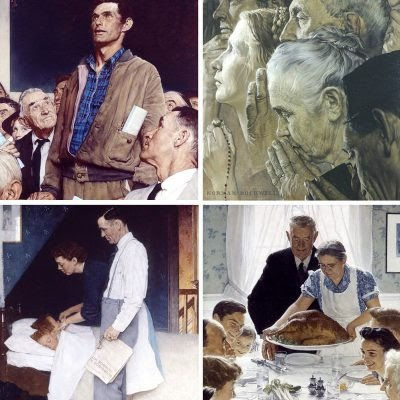Norman Rockwell: A Shift in an Artist
- voicesofgenz
- Sep 4, 2020
- 3 min read
Updated: Oct 27, 2020
By Clara Pressey

Norman Rockwell’s “Triple Self-Portrait” (1959). Image via Norman Rockwell Museum
Norman Rockwell.
What comes into your mind when you read that name? Maybe images of sock hops and milkshakes? Perhaps you start to think of idyllic family Christmases?
Norman Rockwell’s art is traditionally associated with ideas of the “American Dream", and for good reason. Most of his career (47 years of it, to be exact) was spent painting covers for The Saturday Evening Post, where he depicted images of an idealized day-to-day life in America that ignored its flaws and challenges.
But there’s also a much deeper side to many of his works. Just take a look at his “Four Freedoms” paintings.
In 1943, Rockwell was inspired by Franklin D. Roosevelt’s famous “Four Freedoms Speech,” and wanted to find a way to represent it in his art. If you’re not familiar with the speech, it lists four freedoms that FDR viewed as essential to humanity: freedom of speech, freedom of worship, freedom from fear, and freedom from want. Rockwell found a model to paint “Freedom of Speech” after witnessing one of his neighbors voice an opinion at a town hall meeting in Arlington, Vermont, and the other paintings followed.

Norman Rockwell’s “Freedom of Speech” (upper left), “Freedom of Worship” (upper right), “Freedom from Fear” (lower left), and “Freedom from Want” (lower right). Images via Norman Rockwell Museum.
The paintings were used as the covers of four issues of The Saturday Evening Post and were accompanied by short essays. They subsequently became extremely popular, and through the sale of liberty bonds and tickets to see them on tour, raised over $130 million for the war effort.
Rockwell’s art from this period of his career also depicted more direct aspects of the war. His character Willie Gillis was present on multiple covers of the Post that chronicled the character’s journey as a young man drafted into the war.
Rockwell’s artistic interpretation of Rosie the Riveter is striking in comparison to others. She is painted as a worker — complete with an actual tool, muscles, and covered in soot — while many other depictions show her only as an image of picture-perfect traditional femininity.

Norman Rockwell’s “Willie Gillis in Convoy” (1943) and “Rosie the Riveter” (1943). Images via Norman Rockwell Museum.
While Rockwell’s war-era art holds some contrast to his depictions of day-to-day life, it wasn’t until the 60s that his art began to take on more serious topics — particularly the Civil Rights Movements.
Until 1961, the Post refused to portray people of color on their covers as anything but workers serving white people — which is simply just not okay. On April 1st of that year, they did use Rockwell’s “Golden Rule” painting, which featured POC, for a cover, but he ceased his work for the Post in 1963 and moved to Look Magazine, where he began to paint harsher realities and racial tensions in the U.S.
Most prominently among these paintings was “The Problem We All Live With,” which depicted five-year-old Ruby Bridges — a young girl who had to be escorted to school by U.S. Marshalls in 1960. The painting was brought to the White House in 2011 by President Obama. His painting “Murder in Mississippi” (also known as “Southern Justice”) represented the events of the horrific Mississippi Burning Murders, with members of the Klu-Klux-Klan looming in the background.

Norman Rockwell’s “The Problem We All Live With” (1964). Image via Norman Rockwell Museum.
In 1968, Rockwell was asked to create a piece in support of the Vietnam War. Instead, he painted “The Right to Know,” which was meant to critique the government’s lack of transparency and consistent streak of dishonesty with the American public at that time.

Norman Rockwell’s “The Right to Know” (1968). Image via George Washington University.
As time has progressed, much of Rockwell’s later art has retained its power. Even the Four Freedoms paintings from the earlier portion of his career hold onto their impact. But their impact needs to be adapted for today’s world, where different lives and unique experiences can and should be celebrated and brought to the center of art.
In 2016, artist Hank Williams Thomas, Eric Gottesman, founder of For Freedoms, and photographer Emily Schur reimagined the “Four Freedoms” paintings with the same themes, but a more diverse and accurate representation of America. A new American Dream. A more just American Dream. A more beautiful American Dream.

Norman Rockwell’s “Freedom of Speech” (top left) (featuring actress and activist Rosario Dawson), “Freedom from Want” (top right), Freedom from Fear” (bottom left), and “Freedom of Worship” (bottom right), as interpreted by Hank Williams Thomas, Eric Gottesman, and Emily Schur. Images via Art Critique.
Written by writer Clara Pressey

コメント